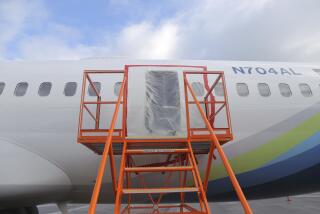Focus Shifts to Why Learjet Crashed
MINA, S.D. — How the airplane carrying pro golfer Payne Stewart and five others crashed last week seems pretty certain. Why it crashed is another matter.
National Transportation Safety Board investigators say privately that there now is little doubt that the Learjet 35 depressurized as it reached about 39,000 feet after taking off from Orlando, Fla., en route to Texas.
This depressurization almost certainly rendered the plane’s occupants unconscious within seconds and probably killed them within minutes. Killed were Stewart; the plane’s pilots, Michael Kling and Stephanie Bellegarrigue; Stewart’s agents, Robert Fraley and Van Ardan; and golf course designer Bruce Borland.
Wreckage, Records Still to Be Studied
The twin-engine jet apparently flew on autopilot for 1,400 miles before running out of fuel and crashing near this agricultural town of 25 residents.
Investigators have pieced together that much about how the accident likely occurred from radar data and the observations of Air Force pilots who scrambled to escort the wayward jet after air traffic controllers were unable to contact the Learjet pilots.
Now the NTSB must sift through mangled wreckage and pore over thousands of pages of records in an effort to come up with some logical explanation for why the depressurization occurred and why the pilots were unable to do anything about it.
“Certainly, it’s not going to be an easy investigation,” said Robert T. Francis, the NTSB vice chairman overseeing the investigation.
Bob Benzon, the investigator in charge, said he is optimistic about figuring out what happened to Stewart’s plane--although he cautioned that the NTSB’s findings likely won’t be absolute. “What we’re asked to find is the probable cause,” he said. “Probable.”
The NTSB has finished its work here in Mina--a hamlet of eight modest houses, a boarded-up church, a meeting house, a grain elevator and a rundown watering hole called Montana’s Bar.
Recorder May Hold Vital Information
Since only a couple of people saw the plane go down, most of the NTSB’s efforts here involved the recovery of human remains and shattered airplane debris from the 10-foot-deep crater gouged in the moist earth of a cow pasture.
The human remains have been taken to coroner’s facilities in various cities. The airplane wreckage has been piled in a hangar at the airport in Aberdeen, a regional center about 12 miles up the road.
Benzon said that, because the Learjet hit the ground at a high speed, the damage was extreme. Although most of the plane’s key components have been recovered, many of them have been torn into such small, twisted pieces that finding meaningful clues will prove formidable.
The plane’s “black box” cockpit voice recorder was heavily damaged, but Benzon said investigators still hope to glean useful information from it--such as wind sounds that might indicate the source of depressurization.
The NTSB will study the plane’s maintenance files and the pilots’ training records--which all appear normal--searching for clues. Histories of other Learjet crashes, including one in 1988 that involved depressurization, will also be examined.
The military pilots who were deployed to attempt to establish contact with the Learjet saw that its windows were frosted over, leading them to conclude that the plane had somehow depressurized, incapacitating everyone on board.
Those conclusions are shared by the NTSB, in large part because no one has thought of any other logical answer. Depressurization would explain the frost, since decompression causes water vapor in the air to condense on flat surfaces, and temperatures above 30,000 feet would swiftly drop to below zero.
Why the depressurization would have occurred is unknown, although experts have suggested several possible scenarios. These include the failure of the modulator valves that control the flow of air pumped by the engines into the cabin, the failure of an interior pressure bulkhead on the plane and the failure of the outflow valve that bleeds off excess air pressure.
There’s also the possibility that a door or window seal failed, although the military pilots said they could see no sign of such damage.
Depending on the scenario, the plane could have decompressed slowly or rapidly, and either possibility raises more questions.
If depressurization was slow, alarms and a gauge should have alerted the cockpit crew in plenty of time to take successful corrective action. Even if depressurization was swift and without warning, the pilots should have had the few seconds it takes to grab the emergency oxygen masks in their headrests.
Did the alarm systems fail? Did the pilots ignore the gauge and symptoms--such as tingling and lightheadedness, that warn of high-altitude hypoxia? Did the emergency oxygen system fail? Did the pilots simply fail to make sure the system was working, as required during their preflight checks?
Data provided by Francis show that neither pilot had much experience with a Learjet. Kling, the pilot in command, had more than 4,000 hours of total flight time but only 37 hours of it in a Learjet. Bellegarrigue had about 2,000 hours total time, only 250 of it in a Learjet. Was the pilots’ relative inexperience in a Learjet a factor in the accident?
Those are the questions Benzon and his investigators hope to answer in the weeks ahead.
More to Read
Sign up for Essential California
The most important California stories and recommendations in your inbox every morning.
You may occasionally receive promotional content from the Los Angeles Times.










